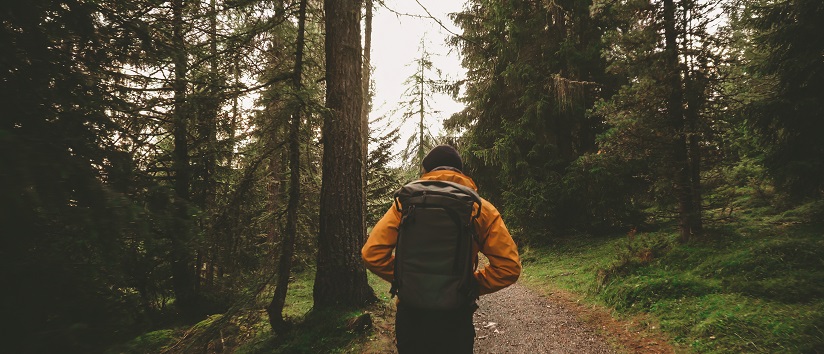Forest bathing: how returning to the trees can decrease symptoms of anxiety
28 April 2021
Imagine you’re in a forest. Close your eyes, hear the rustle of the wind through the leaves, a ray of sun moves through the branches and catches your face, warming your skin, feel the rough bark on the trunk of a huge tree, smell the sweet green of pine and tree sap, feel the snap of twigs underfoot.
Tuning into the here and now has long been a practice of mindfulness. Mindfulness gives people the ability to understand and accept their thoughts as just that, thoughts and to know they’re safe in the present moment.
Shinrin-yoku or as it is more commonly known, forest bathing is the Japanese practice of immersing oneself in nature, especially in forests and paying particular attention to how that environment engages the five senses. It is another step on from mindfulness that harmonises with nature and results in what Kate Bast, a certified nature and forest therapy guide in Wisconsin, calls “mindlessness”.
- See also: '“Climb your mind” The relationship between mental adversity and the mountains'
- See also: 'Cold-water swimming is the latest must try for improving wellbeing and mental health'
- See also: 'How can you help someone struggling with anxiety? – expert tips'
Bast has said, forest therapy or forest bathing is like a “balm” for mental health and that it has the ability to slow down the fight, flight or freeze response, which is so often on high alert for those with anxiety. Forest bathing, Bast said also softens the intensity of symptoms such as ‘rumination’ which is something that often plagues those living with depression.
But how does it really work, and why trees?
The culture in Japan has long respected old forests and woodlands, with large trees holding particular importance. In Shinto they believe in Kodama, which are simply spirits that inhabit old trees.
In the 1980s a wave of studies, including one by researchers in Nagano, found that time in forests and woodlands could actually reduce blood pressure, lower cortisol levels (the hormone involved in stress), and even improve memory and ability to focus.
A chemical released by trees called phytoncides was also found to boost the immune system. The benefits seemed to be immeasurable and so the Japanese government made it a part of the country’s health programme, prescribed by doctors in what is now known as ‘social prescribing’.
Social prescribing can be anything from gardening groups, mountain, fell or hill walking, sports and exercise groups, cold-water swimming, looking after animals such as horses, spending time in public parks, walking in forests, even cookery classes.
Shinrin-yoku is understood in Japan as a kind of preventative medicine, not a catch all or something to prescribe when someone is in crisis. Although it may help ease the symptoms of someone experiencing severe mental illness, the idea is instead to engage in this activity regularly, adapt and change it in whatever way suits your schedule, but making it a part of your life will see the best results.
Dr Qing Li, the president of the Society for Forest Medicine in Japan, heads to a park in Tokyo where there are trees and leaves once a day every day whilst at work. Then, when his schedule permits, once a month he spends three days in forests near Tokyo. Li has spoken about the adverse negative effects of the fact that so many modern, urban dwelling people spend most of their lives inside.
During forest bathing sessions he encourages people to leave their phones and cameras at home, instructing people that “You are going to be walking aimlessly and slowly… You are savouring the sounds, smells and sights of nature and letting the forest in.”
This notion of “letting the forest in” is at the core of forest bathing.
Shelby Deering, writing for Healthline on her experience of a guided forest bathing session that she believed for years that simply going to wooded areas, for a run or a hike would give her the same benefits, but that having experienced a real forest bathing session “now I know the difference”.
Upon being “invited” to notice by her guide, Kate Bast, Deering was astounded at how much she would miss during her runs, “the spider spinning a sunlight-soaked web. The dew on the flowers. How the smells change as I move…from wet and earthy to fresh and floral.”
Gary Evans, who set up the UK’s Forest Bathing Institute in 2018 speaks on the same experience: “People initially think they’ve been doing this all their lives: going for a walk in the woods” but he notes people are often distracted.
Instead, he frames forest bathing simply as “mindful time spent under the canopy of trees.”
Evans explains that it is the sensory exercises that differentiates forest bathing with other outdoor exercise that simply ask us to be outside.
Taking time to engage in their surroundings, as Shelby Deering did, people notice subtle changes in colour, patterns, smell, the terrain of the ground underfoot.
As forest bathing is such a new practice in the UK and certainly not commonly prescribed, or available in guided format privately in many places, we are years behind Japan in their understanding of its benefits.
However, the studies that have been done, all being held in Asia and Europe, have positive results.
One, published in July of last year demonstrated exceedingly positive results for those partaking in the study who experienced anxiety. The researchers noted that all participants with anxiety experienced a decrease in symptoms from pre-shinrin-yoku to post shinrin-yoku.
All studies on the effects of forest bathing, as with most research on social prescribing, acknowledge the need for larger studies, with more controls and with the aim to compare their effectiveness against more traditional therapies such as CBT.
Another study, published in Japan last year concluded that because of its findings “Urban planners should pay more attention to maintaining and increasing accessible greenery in urban areas.”
Stuart Dainton of the Woodland Trust in the UK (who actually recommended that forest bathing be picked up as social prescribing in the UK in 2019) commented that not everyone can get to a forest so easily, and so also emphasised the importance parks, saying “taking off your shoes in the local park and feeling the grass will help you de-stress.”
Access to these spaces and how important it is that they are made available has never been made more pertinent than during the past year of the current COVID-19 pandemic. The Office of National Statistics (ONS) recently published analysis of how our relationship with the outdoors and nature has changed because of lockdowns and the pandemic.
They reported that 40% of those surveyed noticed that “nature, wildlife and visiting local green and natural spaces have been more important to their wellbeing since the coronavirus restrictions began.”
ONS also reported on how location played a huge part in this ability to access green spaces. Those who were closer to a public park were far more likely to make the effort to spend time in it, raising the question on whether the creation of more green spaces needs to be a part of the government response to the post pandemic mental health crisis.
This is clearly on the minds of some as an initiative called ‘Future Parks’ has been launched by the National Lottery and in conjunction with National Trust to fund, expand already existing plans and spaces, maintain and create green spaces at the heart of communities in locations such as Birmingham, Bristol, Edinburgh, Islington and Camden and Nottingham.
Ruminating on her experience of a guided forest bathing session in Wisconsin, Shelby Deering took away, even a week later, “a quieted mind” and a feeling of “slowing down” with a new ability to sleep soundly and easily.
These positive effects should come as no surprise really. We, as humans have starved ourselves of time spent amongst trees and nature, so brutally for the past two hundred years. After the industrial revolution and the expanding of cities into green spaces we have lost touch with our very literal roots, as humans, in nature.
If only a walk around a local park, or old cemetery, or one long day trip to a forest a month, or every two months; clearly, it’s time to re-connect with these tree spirits, these Kodama, who are sat patiently, waiting for us to join them.
To find out more about opportunities for forest bathing and the best locations for it you can visit the Forest Bathing Institute here and discover the forests and woodlands near you on the National Trust’s page on forest bathing here.


Comments
Write a Comment
Comment Submitted